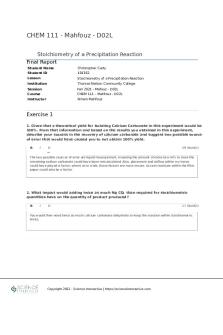LAB 5 Stoichiometry PDF

| Title | LAB 5 Stoichiometry |
|---|---|
| Author | Sanchit |
| Course | General Chemistry I Laboratory |
| Institution | The University of Tennessee at Chattanooga |
| Pages | 3 |
| File Size | 102.3 KB |
| File Type | |
| Total Downloads | 52 |
| Total Views | 146 |
Summary
stoichiometry assignment...
Description
Name : Mohammad Alhilal Part A Fe2O3 + 3CO 2Fe + 3CO2 1. Look at the coefficients (such as the “3” in 3CO) in front of each substance in the equation. The coefficients tell you how many molecules or atoms take part in a chemical reaction. In the spaces below, list the number of each molecule or atom in the equation. Fe2O3: 1
2.
CO :3
Fe :2
CO2 : 3
In a balanced equation, the same number of each kind of atom is shown on each side of the equation. Calculate the number of iron (Fe), oxygen (O), and carbon atoms (C) Reactants
Iron: 2
Oxygen: 6
Carbon: 3
Products
Iron: 2
Oxygen: 6
Carbon: 3
Based on these values, is the equation balanced? - Balanced
Activity A: Question: How do scientists find the molecular mass and molar mass of a substance? 1. Calculate: The molecular mass of a molecule is the sum of the masses of each atom in the molecule. The unit of molecular mass is the universal mass unit (u). Iron’s atomic mass is 55.85 u, carbon’s mass is 12.01 u, and oxygen’s mass is 16.00 u. A.
Calculate the molecular mass of carbon monoxide (CO) by adding the atomic mass of carbon and the atomic mass of oxygen : 28.01 u
B.
Calculate the molecular mass of carbon dioxide (CO2): 44.0 u
C.
Calculate the molecular mass of iron (III) oxide (Fe2O3): 159.7 u
2. Infer: A mole of a substance has a mass in grams that is equal to the molecular mass. For example, a carbon atom has a mass of 12.01 u. A mole of carbon has a mass of 12.01 g. Based on their molecular masses, list the molar mass of each substance A. Fe2O3: 159.7 B. CO : 28.01 C. Fe: 55.85 D. CO2 : 44.0
3. Practice: Hydrogen has an atomic mass of 1.01 u. What is the molar mass of these substances?
H2O : 18.02u CH4:16.04u H2CO3:62.03u C6H12O6 : 180.156u
Activity B : 1. Observe: The first question is: “How many moles of carbon monoxide (CO) are required to react completely with 1.75 moles of iron (III) oxide (Fe2O3)?” (If this is not the question you see, click New question until it appears.) A. What unit is given in the question? moles B. What quantity is asked for? moles
2. Find: Look for the conversion factor that contains the units “mol Fe2O3” on top and “mol CO” on the bottom. Drag the tile containing this factor down to the green strip at the bottom. According to the tile, how many moles of CO react with one mole of Fe2O3? - 3
3. Analyze: To get an answer in moles of CO, you need to cancel the moles of Fe2O3. Turn on Show units. A. What units are given to the right of the equals sign? moles B. If these aren’t the units you want, click Flip tile. What unit is given now? moles
4. Calculate: If the units are correct, multiply or divide the numbers to solve the problem. A. How many moles of CO will react with 1.75 moles of Fe2O3? 5.25 B. Turn on Show numerical result. Were you correct? _YES__
Problems (units 0.1 point each, solution 0.683 points each): A. What mass of iron (Fe) can be obtained from 3.80 g iron (III) oxide (Fe2O3) reacting with excess carbon monoxide (CO)? Given unit: g
Answer unit: _g_
Solution: 2.6577g
B. How many moles of iron (Fe) will be produced from 6.20 moles of carbon monoxide (CO) reacting with excess iron (III) oxide (Fe2O3)? Given unit: ___ moles ____ Answer unit: _moles_____
Solution: 4.1233 moles
C. How many molecules of carbon monoxide (CO) are needed to react with excess iron (III) oxide (Fe2O3) to produce 11.6 g of iron (Fe)? Given unit: ___ g ____
Answer unit: _moles___
Solution: _0.311__...
Similar Free PDFs

LAB 5 Stoichiometry
- 3 Pages

Lab Report 8 stoichiometry
- 10 Pages

Stoichiometry Lab Report
- 6 Pages

Stoichiometry lab report
- 3 Pages

Lab 3 Stoichiometry lab report
- 8 Pages

Stoichiometry Experiment Lab
- 5 Pages

Lab 3 Stoichiometry
- 10 Pages

CHM-113L-lab 3-Stoichiometry
- 5 Pages
Popular Institutions
- Tinajero National High School - Annex
- Politeknik Caltex Riau
- Yokohama City University
- SGT University
- University of Al-Qadisiyah
- Divine Word College of Vigan
- Techniek College Rotterdam
- Universidade de Santiago
- Universiti Teknologi MARA Cawangan Johor Kampus Pasir Gudang
- Poltekkes Kemenkes Yogyakarta
- Baguio City National High School
- Colegio san marcos
- preparatoria uno
- Centro de Bachillerato Tecnológico Industrial y de Servicios No. 107
- Dalian Maritime University
- Quang Trung Secondary School
- Colegio Tecnológico en Informática
- Corporación Regional de Educación Superior
- Grupo CEDVA
- Dar Al Uloom University
- Centro de Estudios Preuniversitarios de la Universidad Nacional de Ingeniería
- 上智大学
- Aakash International School, Nuna Majara
- San Felipe Neri Catholic School
- Kang Chiao International School - New Taipei City
- Misamis Occidental National High School
- Institución Educativa Escuela Normal Juan Ladrilleros
- Kolehiyo ng Pantukan
- Batanes State College
- Instituto Continental
- Sekolah Menengah Kejuruan Kesehatan Kaltara (Tarakan)
- Colegio de La Inmaculada Concepcion - Cebu







